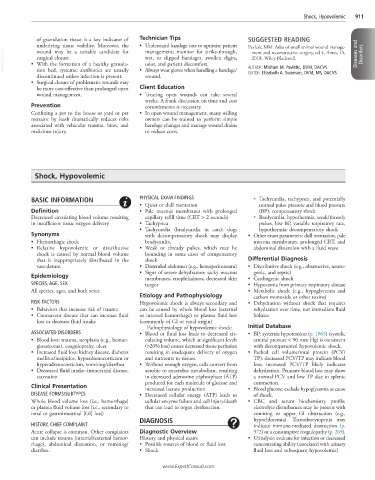Page 1818 - Cote clinical veterinary advisor dogs and cats 4th
P. 1818
Shock, Hypovolemic 911
of granulation tissue is a key indicator of Technician Tips SUGGESTED READING
underlying tissue viability. Moreover, the • Understand bandage care to optimize patient Pavletic MM: Atlas of small animal wound manage-
VetBooks.ir • With the formation of a healthy granula- wet, or slipped bandages, swollen digits, AUTHOR: Michael M. Pavletic, DVM, DACVS Diseases and Disorders
management; monitor for strike-through,
wound may be a suitable candidate for
ment and reconstructive surgery, ed 4, Ames, IA,
surgical closure.
2018, Wiley-Blackwell.
odor, and patient discomfort.
tion bed, systemic antibiotics are usually
wound.
discontinued unless infection is present. • Always wear gloves when handling a bandage/ EDITOR: Elizabeth A. Swanson, DVM, MS, DACVS
• Surgical closure of problematic wounds may
be more cost-effective than prolonged open Client Education
wound management. • Treating open wounds can take several
weeks. A frank discussion on time and cost
Prevention commitments is necessary.
Confining a pet to the house or yard or pet • In open wound management, many willing
restraint by leash dramatically reduces risks owners can be trained to perform simple
associated with vehicular trauma, bites, and bandage changes and manage wound drains
malicious injury. to reduce costs.
Shock, Hypovolemic
BASIC INFORMATION PHYSICAL EXAM FINDINGS ○ Tachycardia, tachypnea, and potentially
• Quiet or dull mentation normal pulse pressure and blood pressure
Definition • Pale mucous membranes with prolonged (BP): compensatory shock
Decreased circulating blood volume resulting capillary refill time (CRT > 2 seconds) ○ Bradycardia, hypothermia, weak/thready
in insufficient tissue oxygen delivery • Tachypnea pulses, low BP, variable respiratory rate,
• Tachycardia (bradycardia in cats); dogs hypothermia: decompensatory shock
Synonyms with decompensatory shock may display • Other exam parameters: dull mentation, pale
• Hemorrhagic shock bradycardia. mucous membranes, prolonged CRT, and
• Relative hypovolemic or distributive • Weak or thready pulses, which may be abdominal distention with a fluid wave
shock is caused by normal blood volume bounding in some cases of compensatory
that is inappropriately distributed in the shock Differential Diagnosis
vasculature. • Distended abdomen (e.g., hemoperitoneum) • Distributive shock (e.g., obstructive, neuro-
• Signs of severe dehydration: tacky mucous genic, and septic)
Epidemiology membranes, enophthalmos, decreased skin • Cardiogenic shock
SPECIES, AGE, SEX turgor • Hypoxemia from primary respiratory disease
All species, ages, and both sexes • Metabolic shock (e.g., hypoglycemia and
Etiology and Pathophysiology carbon monoxide or other toxins)
RISK FACTORS Hypovolemic shock is always secondary and • Dehydration without shock that requires
• Behaviors that increase risk of trauma can be caused by whole blood loss (external rehydration over time, not immediate fluid
• Concurrent disease that can increase fluid or internal hemorrhage) or plasma fluid loss boluses
loss or decrease fluid intake (commonly of GI or renal origin)
Pathophysiology of hypovolemic shock: Initial Database
ASSOCIATED DISORDERS • Blood or fluid loss leads to decreased cir- • BP: systemic hypotension (p. 1065) (systolic
• Blood loss: trauma, neoplasia (e.g., heman- culating volume, which at significant levels arterial pressure < 90 mm Hg) is consistent
giosarcoma), coagulopathy, ulcer (>20% loss) causes decreased tissue perfusion with decompensated hypovolemic shock.
• Increased fluid loss: kidney disease, diabetes resulting in inadequate delivery of oxygen • Packed cell volume/total protein (PCV/
mellitus/insipidus, hypoadrenocorticism or and nutrients to tissues. TP): decreased PCV/TP may indicate blood
hyperadrenocorticism, vomiting/diarrhea • Without enough oxygen, cells convert from loss; increased PCV/TP likely indicates
• Decreased fluid intake: intracranial disease, aerobic to anaerobic metabolism, resulting dehydration. Peracute blood loss may show
starvation in decreased adenosine triphosphate (ATP) a normal PCV and low TP due to splenic
produced for each molecule of glucose and contraction.
Clinical Presentation increased lactate production. • Blood glucose: exclude hypoglycemia as cause
DISEASE FORMS/SUBTYPES • Decreased cellular energy (ATP) leads to of shock.
Whole blood volume loss (i.e., hemorrhage) cellular enzyme failure and cell injury/death • CBC and serum biochemistry profile:
or plasma fluid volume loss (i.e., secondary to that can lead to organ dysfunction. electrolyte disturbances may be present with
renal or gastrointestinal [GI] loss) vomiting or upper GI obstruction (e.g.,
DIAGNOSIS hypochloremia). Thrombocytopenia may
HISTORY, CHIEF COMPLAINT indicate immune-mediated destruction (p.
Acute collapse is common. Other complaints Diagnostic Overview 972) or a consumptive coagulopathy (p. 269).
can include trauma (internal/external hemor- History and physical exam: • Urinalysis: evaluate for infection or decreased
rhage), abdominal distention, or vomiting/ • Possible sources of blood or fluid loss concentrating ability (associated with urinary
diarrhea. • Shock fluid loss and subsequent hypovolemia)
www.ExpertConsult.com

